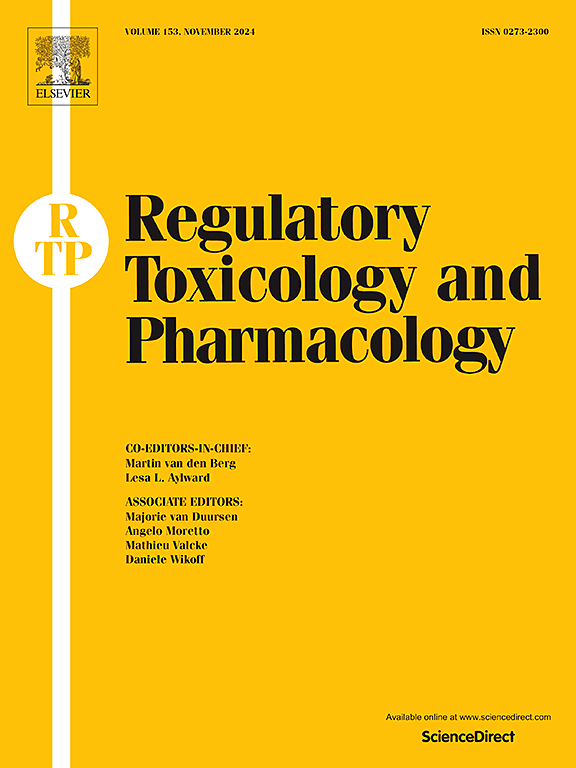Ames mutagenicity of 15 aryl, benzyl, and aliphatic ring N-nitrosamines
IF 3
4区 医学
Q1 MEDICINE, LEGAL
引用次数: 0
Abstract
The Ames mutagenicity test is an effective means of screening compounds for their carcinogenic potential. Here, we conducted Ames tests on 15 aryl, benzyl, and aliphatic ring N-nitrosamines. Then, by using two indicators of mutagenicity strength calculated from the Ames test results, namely, maximum specific activity (MSA; number of revertant colonies) and maximum fold increase (MFI; relative ratio of increased colonies), we examined the relationship between Ames mutagenicity strength and Carcinogenic Potency Categorization Approach (CPCA) potency category, which is a structure–activity-relationship–based prediction of the carcinogenic potency of nitrosamines. Eleven of the test compounds were Ames positive and four were negative. Of the 11 positive compounds, three were categorized as strong positive (MSA ≥1000), five as medium positive (100 ≤ MSA <1000), and three as weak positive (MSA <100). The compounds with an aliphatic ring showed a negative relationship between mutagenicity strength (i.e., MSA or MFI) and carcinogenic potential (i.e., CPCA category), whereas, the alpha-methyl aryl N-nitrosamines did not. Overall, MSA and MFI were found to be detailed indicators of the carcinogenic potency of the N-nitrosamines and can potentially be used to support CPCA categorization.
15种芳基、苄基和脂肪环n -亚硝胺的Ames诱变性。
Ames诱变试验是筛选化合物致癌潜力的有效手段。在这里,我们对15个芳基、苄基和脂肪环n -亚硝胺进行了Ames测试。然后,利用Ames试验结果计算的两个致突变性强度指标,即最大比活性(MSA);复归菌落数)和最大倍数增加(MFI;),我们研究了Ames诱变强度与致癌效能分类方法(Carcinogenic Potency Categorization Approach, CPCA)效能类别之间的关系,CPCA是一种基于结构-活性关系的亚硝胺致癌效能预测方法。11个测试化合物为Ames阳性,4个为阴性。11个阳性化合物中,3个为强阳性(MSA≥1000),5个为中阳性(100≤MSA < 1000), 3个为弱阳性(MSA < 100)。含有脂肪环的化合物在致突变性强度(即MSA或MFI)和致癌潜力(即CPCA类别)之间呈负相关,而α -甲基芳基n -亚硝胺则没有。总的来说,MSA和MFI是n -亚硝胺致癌性的详细指标,可能用于支持CPCA分类。
本文章由计算机程序翻译,如有差异,请以英文原文为准。
求助全文
约1分钟内获得全文
求助全文
来源期刊
CiteScore
6.70
自引率
8.80%
发文量
147
审稿时长
58 days
期刊介绍:
Regulatory Toxicology and Pharmacology publishes peer reviewed articles that involve the generation, evaluation, and interpretation of experimental animal and human data that are of direct importance and relevance for regulatory authorities with respect to toxicological and pharmacological regulations in society. All peer-reviewed articles that are published should be devoted to improve the protection of human health and environment. Reviews and discussions are welcomed that address legal and/or regulatory decisions with respect to risk assessment and management of toxicological and pharmacological compounds on a scientific basis. It addresses an international readership of scientists, risk assessors and managers, and other professionals active in the field of human and environmental health.
Types of peer-reviewed articles published:
-Original research articles of relevance for regulatory aspects covering aspects including, but not limited to:
1.Factors influencing human sensitivity
2.Exposure science related to risk assessment
3.Alternative toxicological test methods
4.Frameworks for evaluation and integration of data in regulatory evaluations
5.Harmonization across regulatory agencies
6.Read-across methods and evaluations
-Contemporary Reviews on policy related Research issues
-Letters to the Editor
-Guest Editorials (by Invitation)

 求助内容:
求助内容: 应助结果提醒方式:
应助结果提醒方式:


